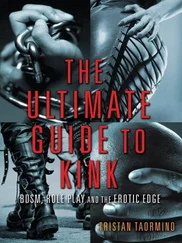For other Transvestites, only particular costumes satisfied their deepest urges. One Lady confessed to Hirschfeld that his mother’s cream-colored damask dress, which he furtively wore on the day of his church confirmation, stimulated his first erection and was a necessary sex aid ever since. Another patient wrote that the mere donning of a frilly lace skirt caused him to orgasm uncontrollably. No other clothing or sexual companionship did the trick.
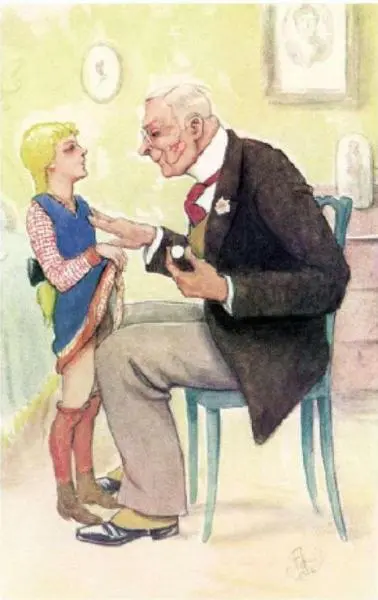
Viktor Leyrer, The Good Uncle
Hirschfeld’s designation of Homosexual men and women, the so-called Third Sex, as Sexual Intermediaries, created the most controversy. He believed they, like the other Intersexuals, were constitutionally predisposed in their sexual desires as “incomplete” mature males and females. The theory enhanced queers’ legal status as helpless victims of faulty chromosomes—and the mass struggle against Paragraph 175—but its scientific and social value was challenged on every front. Militant Homosexualists ridiculed the secretive Papa as “Auntie Magnesia,” a cross-dressing sissy and cosmopolitan Jew. Of course, it was hardly noticeable to Hirschfeld’s antagonists, that the ever-protean and devoted sexologist incorporated their scientific objections into his evolving grid of transsexuality.
Derangements of the Sexual Instinct
Hirschfeld also conducted extensive research in more traditional sexual behavior, especially in the field of sexual pathology, which he cataloged as the “Derangements of the Sexual Instinct.” His sweep here ran from the study of self-castration and impotence to “hypereroticism” and “coital hallucination.” Why individuals would choose to obliterate or compulsively bind their sexual desires to inanimate objects or childhood/sadomasochistic/power-exchange scenarios fascinated Hirschfeld. For Central European psychologists, the answer touched upon the fundamental twentieth-century issue in human behavior: how much anti-social activity is caused by “natural” elements (genetics and chemical imbalances), and how much by sheer nurture. In other words, were glove fetishists people with obsessive inherited or hormonal traits, like Transvestites, or did some event in their childhood eroticize their morbid attachment to the charged article?
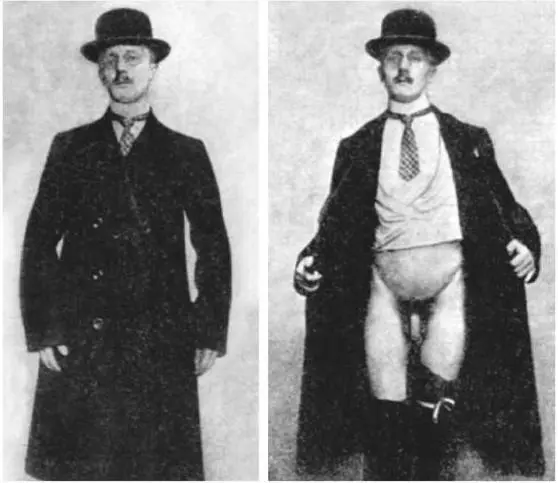
Exhibitionist displaying his “working uniform”
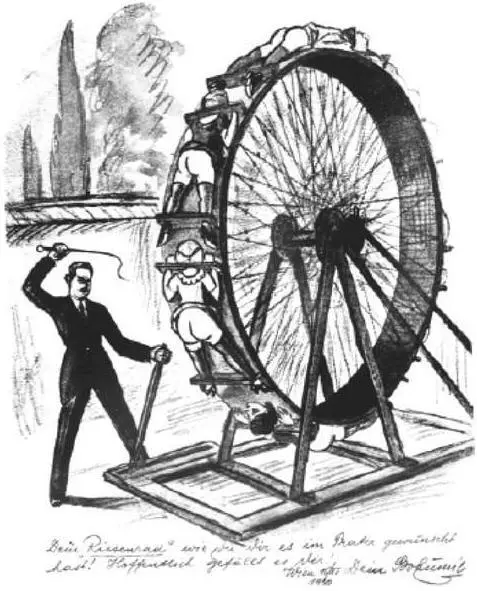
Flagellation drawing by a 17-year-old sadist, 1930
To explore the problem, Hirschfeld prepared an exhaustive 140-part “Psycho-Biological Questionnaire.” The 18,000 Berliners who responded to the survey were asked to reveal their innermost erotic secrets and family background, as one would expect. But also in the sexual profile were inquiries on seemingly isolated topics like shoplifting, color preference, stuttering, feelings on capital punishment and war, left-handedness, and diet. For Hirschfeld and his trained associates, their candid replies were the initial step in correlating heredity, child-rearing, and education with everyday expressive behavior and unconscious sexual desire.
The Psycho-Biological Questionnaires served several purposes, besides their obvious research benefits. Hirschfeld used them clinically to diagnose deeply imbedded sexual disturbances and for premarital counseling. The Einstein of Sex proclaimed that he could help prevent unhappy marriages through his interpretation of the sex surveys. Long-term attraction involved the joining of complementary erotic temperaments. Once the “false fire of passion” diminishes, Hirschfeld stated, coital disappointment naturally occurs. By gazing into the “sexual souls” of the couples, scientific predictions about their overall psychological and physical relationship could be made. While not infallible, Sexual Science at least attempted to point out the barriers to and possible aids for wedded bliss.
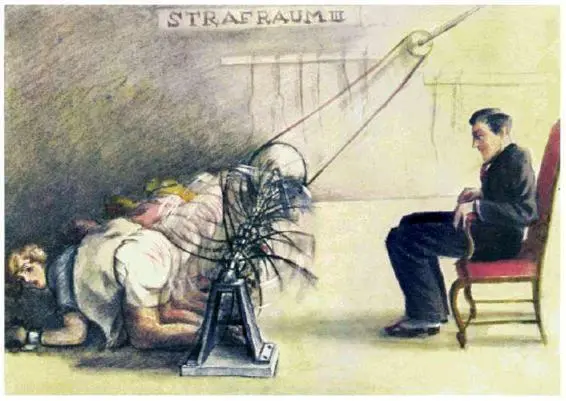
My Invention , fantasy drawing of a sadistic intellectual
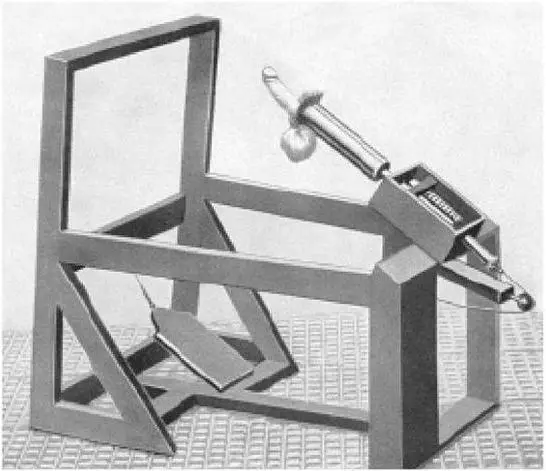
Pedal-driven female masturbation machine manufactured in Dresden, 1926
In a famous quote, “Happy marriages are not made in heaven, but in the laboratory,” Hirschfeld inaugurated hard science’s entry into the matchmaking business. According to the publicity-savvy Papa, even love-at-first-sight did not have a real physical basis. At the end of the day, it was all genes and chemicals, racing through the bloodstream, that kept relationships intact and produced babies.
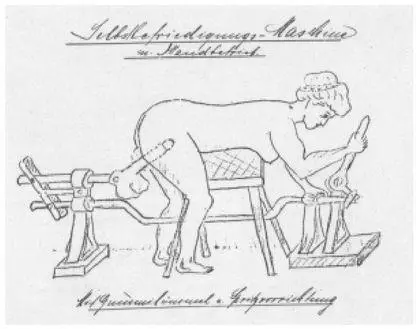
Female “Self-Gratifier,” which squirted milk into the participant, 1900
The Institute of Sexology
In July 1919, Hirschfeld opened his Institute of Sexology in Berlin. It quickly became one of the city’s most curious attractions. The Institute’s buildings, including a former mansion, were divided into areas for lectures, consulting offices, study rooms, laboratories, medical clinics, and a museum space devoted to sexual pathology and erotic folkways. George Gershwin, Ben Hecht, Douglas Fairbanks, André Gide, Sergei Eisenstein, Anita Loos, and Christopher Isherwood (who worked at the Institute) were among the many enthused visitors to Hirschfeld’s Institute, leaving fascinating accounts about its strange inhabitants and artifacts.
Hirschfeld’s Institute functioned as a hospital and a free university under one roof. Medical advice was offered without charge, and scientific lectures by leading sexologists were open to the general public. The Institute’s library, which contained the largest sex and pornographic book collection in Europe, remained accessible to all readers. The Institute also housed Germany’s first Marriage Bureau and clinics for the treatment of venereal disease and other sexual maladies. Politically, the Institute provided a forum for progressive lawyers and government officials who sought to eradicate the laws against homosexuality and defend Germany’s legal abortion rights from the growing onslaught of fascist and religious parties. Most of the legal work involved suits protecting gay men against threats of petty blackmail. These services were also rendered pro bono.
Above the gate of his Institute was the inscription: “ Amori et dolori sacrum ” (“Sacred to Love and to Sorrow”). It was one of many rather banal mottos and plaques that Hirschfeld posted around and inside his foyers and offices. Other Hirschfeldian banners: “Justice Through Science,” “To Understand All is to Forgive All,” “Nature Does Not Make Leaps,” “What the World Calls the Soul, We Call the Endocrine System!”
The Institute itself was a font of sexological activity. Pediatric care, abortions, “sexual rejuvenation” and sexual “correction” operations were conducted on the lower level of the main building. Psychological consultations and tours took place on the upper levels. In the adjoining Ernst Haeckel Hall, films, demonstrations, and public health panels were held for the 1100 physicians who visited the Institute annually. Hirschfeld himself produced and advised on several groundbreaking medical documentaries and silent features, including Richard Oswald’s Different From Others , a film à clef about the torturous life a closeted male violinist. (The title of the 1919 melodrama was later immortalized when it resurfaced as a refrain for the Toppkeller sing-along, the “Lilac Song.”)
Читать дальше









